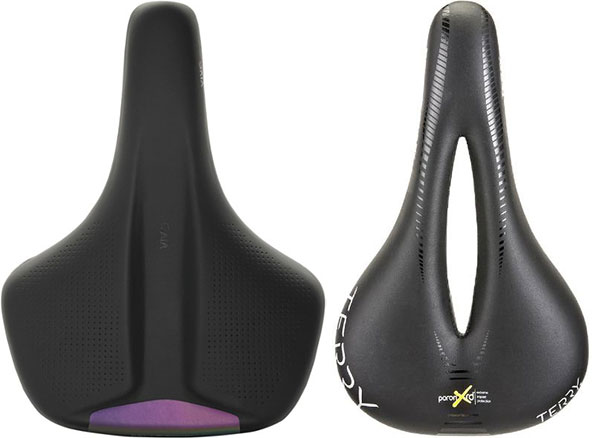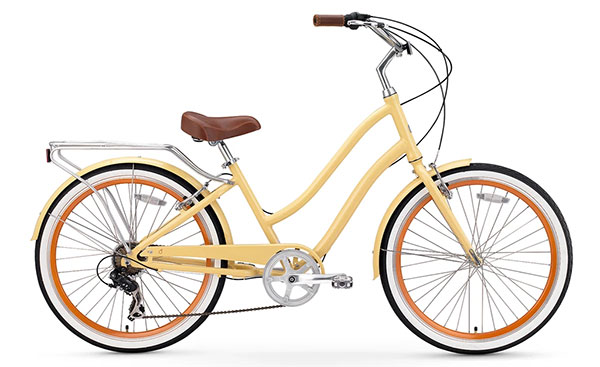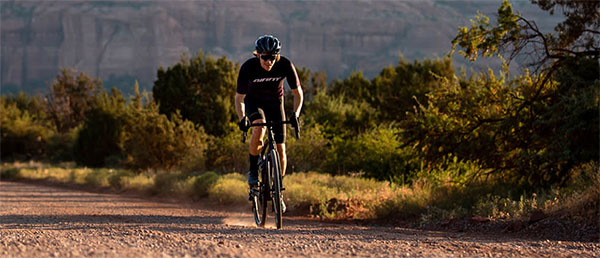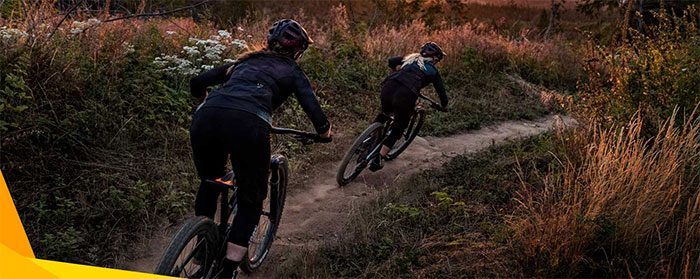Remember when men’s bikes were sportier and better than women’s bikes? While women’s bikes were all about being ‘pretty’ and pink?
Thank goodness those days are long gone. Today, the debate around men’s vs women’s bikes is much more lively!
The differences between men’s and women’s bikes are now minimal, some would say the distinction is necessary, some wouldn’t.
So what are the differences and should we be moving more towards unisex bikes?
Contents
Differences Between Men’s And Women’s Bikes
At first glance, you may think that the differences between a men’s bike vs women’s bike aren’t really there. All that has changed is the size and manufacturers have made the women’s bike pink.
However, this is not the case anymore.
Bike manufacturers aim to allow for anatomical differences between men and women.
What do we mean by that? The difference in size between men and women, mainly. With that comes a small frame size.
For example, you can buy a Liv bike suitable for someone 4’9″. The shortest you can go with the ‘male’ counterpart, Giant is 5’0.
Saddles are often very different when you look at men’s vs women’s bikes. We’ll look more at whys further down but saddles are unique to each rider of whatever gender, so it’s important to get the right fitting one.
With women’s bikes, it does tend to be about shrinking things down, so the stem will be shorter as this increases the reach for the rider, Women have shorter arms so this has to be the case to minimize discomfort.
Handlebar width, crank arm length, and seatpost are all components that you may not notice are different between men’s and women’s bikes but there are often big differences.
Geometry

When you compare men’s vs women’s bikes, you will see that the geometry is different.
Why? Men and women are built differently! This has to be demonstrated in the bike build.
Generally speaking, women’s torsos are shorter than men’s and proportionally they have longer legs. These differences can be seen in women’s bikes as the frames are smaller, with the top tube being shorter.
With women’s bikes, you often have to make almost every component shorter or smaller in size to allow for the build of women.
You also find that women don’t usually get as ‘aero’ as men when riding, purely because women aren’t built that way. So, the racing-style road bikes aren’t as common in women’s road bikes as they are with men.
Women tend to favor the more ‘endurance’ geometry as it’s a more relaxed position for a road bike. Having said that, everyone is different and there is still a market for aero women’s road bikes, just not on the same scale as men’s road bikes.
As for men’s mountain bikes vs women’s mountain bikes, there are some noticeable differences. The main difference is that on a women’s mountain bike, the step-through is present. The step-through design has held strong in the mountain bike world.
This is largely down to the fact that a step-through is easier to mount and dismount, something you might find yourself doing more often when riding a mountain bike!
Handlebars
Women’s bikes tend to have narrower handlebars. Female frames are typically smaller than a man’s, to accommodate this difference, the handlebars on women’s bikes usually include a shorter bar, which is also more narrow. This change means that women don’t have to over-stretch when their hands are on the handlebars.
As someone who once rented a bike in Spain, that had, what felt like, exceptionally wide bars, I don’t think I can stress the importance of getting the right width of handlebars! By the time I had finished cycling that day, my shoulders were in some degree of pain.
Women’s handlebars also tend to be raised. Again, this is down to the fact that women have shorter arms than men so it provides a more comfortable riding position.
Another difference you may notice is that the handle grips on men’s bikes are set wider apart, compared to women’s bikes.
Being in a wider position does tend to give you a stronger grip and better overall control of the bike. This can be especially important if you’re considering a men’s mountain bike or a women’s mountain bike as you’ll want to do tight turns when you’re on the trails.
Saddles

Saddles are unquestionably important to you when you’re riding. Having the wrong saddle can do some lasting damage at worst, at best, it will make your ride uncomfortable.
Men and women are built differently and this is why saddles are one of the big differences when it comes to women’s vs men’s bikes.
On women’s bikes, the saddles are shorter but wider. This is designed to fit the wider hips that women typically have. You may also notice that women-specific saddles have a long hole down the middle.
This is to reduce any pressure on this soft tissue and provides the best amount of support for your sit-bone.
Related: How to Choose Bike Saddles
Your body will notify you quickly when it doesn’t like the saddle too much. However, adjusting the position can help. Sometimes just the slightest change in angle can be all it takes to find the optimum position.
Saddles are one of the easiest components to change on a bike. So, if the one that comes with the bike isn’t suitable, change it to one that works for you!
Other Differences

One standout feature, unique to a woman’s bike is the step-through frame.
Not all women-specific bikes have a step-through frame, you won’t see it on a women’s road bike for example but they are very popular on city or commuter bikes.
Step-through frames came about when ladies wore only long dresses or skirts and a horizontal top tube was not suitable.
The horizontal crossbar would have meant that the rider would have had the lift their legs high, obviously not the done thing when wearing a dress or a skirt!
In response to this, bike manufacturers developed a slanted crossbar, which meant that ladies were able to mount and dismount the bike more modestly.
Another difference that won’t be so obvious is short brake levers.
One key difference between men’s and women’s bikes is the stem. Commonly they are shorter on women’s bikes when compared to a man’s bike, simply due to the fact women have shorter torsos and arms.
The stem helps to reduce the distance between the handlebars and the seat to enable the rider to comfortably reach the handlebars more easily when seated.
See More: Best Bikes For Women
Importance of Having the Right Fit
If you notice that you have numb toes or hands, feeling a bit of knee or lower back pain, or any other types of aches and pains after being on your bike, it’s highly likely it’s due to an imperfect bike fit (or not one at all).
Many people skip getting a professional bike fit when they buy a new bike. However, if you want to ride pain-free and feel at one with your bike, then don’t skip it! So what is a bike fit?
It’s all well and good knowing your height but everyone’s body is different. Your torso might be shorter than the person who is the same height as you.
A slight injury could be affecting how you sit on a bike. We have little to no idea until we get measured. A bike fit can tell you all of this and help get your bike set up to maximize comfort, efficiency, and power.
The great thing is that every touch-point on a bike can be changed, altered, or moved to ensure it fits you better.
A bike fit doesn’t take too long, but it is a worthwhile investment if you want to get the most out of your bike and your performance.
Men Can Still Ride Women’s Bikes

Everybody is different, right? That much is clear – we all come in different shapes and sizes, regardless of our gender. It seems almost unfair to label one bike a ‘women’s road bike’ and another a ‘men’s road bike’, even though there are differences.
What you could find is that a man that has a smaller frame, might be more suited to a woman’s bike or it could be that a woman prefers riding a man’s road bike.
So what do you do? A lot of manufacturers are moving away from gender-specific bikes so it’s becoming increasingly difficult to buy a ‘woman’s bike’ (with the exception of some brands like Liv or Juliana, both produce women-specific mountain bikes).
As manufacturers move away from men’s vs women’s bikes, the trend is now unisex bikes. No genders, just bikes.
And unisex bikes are here to stay. They might not be perfect for everyone, but modern bikes allow you to tweak them a bit. When you look at the options in bike stores, most of them are unisex bikes by default.
One possible issue, that we’ve had is that the specifications can be worse on the women’s bike compared to the male counterpart, which seems very unfair to say the least.
That’s the crucial thing, how the bike fits you. Being uncomfortable can lead you to have a miserable ride – nobody wants that! Find the bike that fits you the best, don’t worry about the labels.
Frequently Asked Questions
Is it ok for a woman to ride a man’s bike?
It’s completely ok for a woman to ride a man’s bike or vice versa. The important thing is how the bike fits, that has to be right.
What is the difference between men’s and women’s bikes?
The big difference between men’s and women’s bikes is that the frames tend to be smaller for women due to their smaller build generally. Saddles, handlebars, and other smaller things can be different too but the big difference is the overall geometry of the bike.
Why are male and female bike frames different?
Men and women are built differently. Women tend to have shorter torsos but proportionally longer lengths, which changes how the bike needs to be set up in order to ensure maximum comfort.
Can a woman ride a man’s mountain bike?
Yes, as long as they can ride the men’s mountain bike comfortably they can. What could be noticeable is the width of handlebars, they are often very wide on mountain bikes.
Are men’s and women’s bike seats different?
Women usually have wider pelvic bones than men so the saddles need to cater to this. On women’s bikes, the saddles are often shorter and wider, whilst on men’s bikes, they are narrower. This tends to be the way it works out but I’d always recommend a saddle fit from your local bike shop.
Why do women's bikes have a lower crossbar?
Women's bikes have a lower crossbar for easier mounting and comfort. This feature was historically for modesty purposes, and can still apply to women nowadays, but now, it's more about comfort.
What makes a bike a man’s bike?
Usually, it comes down to the frame size, men are commonly built bigger than women, so the bike frames are larger. Though there is nothing stopping a woman riding a man’s bike! Unisex bikes are increasingly becoming the trend.
Final Thoughts
Whilst many manufacturers are favoring the unisex bike approach these days, there are still women’s and men’s bikes out there and now you know the differences!
What bike is best for you?
Whether it’s a women’s bike or not, it has to be the one that fits you the best.
Forget the men’s bike/women’s bike rule. Find what is most comfortable for you to ride and ride on!




